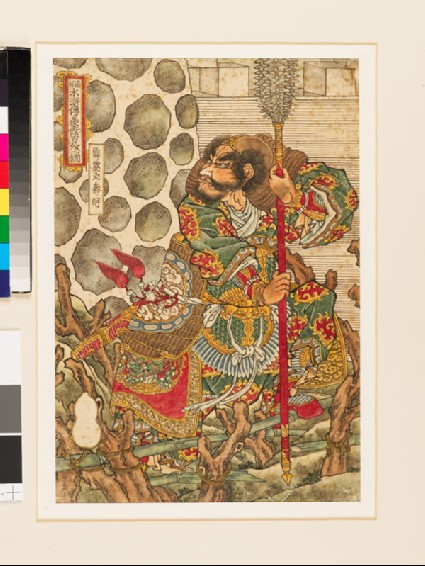Kuniyoshi’s Heroes of China and Japan
A catalogue of the Ashmolean’s collection of warriors by Utagawa Kuniyoshi (1798-1861) by Oliver Impey and Mitsuko Watanabe (published Oxford, 2003).

Publications online: 20 objects
- Reference URL
Actions
Hekirekika Shinmei (Qin Ming)
-
Literature notes
Suikoden chapter 34
Qin Ming was a commander of all the imperial forces around the town of Qingzhou known, on account of his temper and of his loud voice as the ‘Thunderbolt’. His favourite weapon was a ‘wolf-toothed’ mace (ryōgabō). By an involved series of ruses and appalling treachery, he was induced to join the rebels. In this print he stands holding the ‘wolf-toothed’ mace, beside the castle wall, being mistaken for a brigand.
This is not a preparatory sketch for a print, that sent to the blockmaker, a shita-e, for these were extremely sketchy, and the block-cutter had a very considerable input to the final design, controlling all the details. This is a worked-up drawing; possibly by Kuniyoshi with assistants, perhaps as a demonstration for a publisher or possible patron. Nine similar paintings of other heroes are known, all in the National Museum for Ethnology, Leiden. -
Details
- Series
- One of the 108 Heroes of the Popular Water Margin
- Associated place
- Date
- 1827 - 1830
- Artist/maker
-
attributed to Utagawa Kuniyoshi (1797 - 1861) (artist)
- Material and technique
- Nishiki-e, woodblock print, ink and colour on paper
- Dimensions
-
mount 55.3 x 40.2 cm (height x width)
painting 37.5 x 26.1 cm (height x width)
- Material index
- Technique index
- Object type index
- No. of items
- 1
- Credit line
- Presented by George Grigs, Miss Elizabeth Grigs, and Miss Susan Messer, in memory of Derick Grigs, 1971.
- Accession no.
- EA1971.45
-
Further reading
Impey, Oliver, and Mitsuko Watanabe, Kuniyoshi's Heroes of China and Japan: A Selection of Warriors from Two Series of Prints and a Painting by Utagawa Kuniyoshi (1798 - 1861), the Suikoden of 1827 and the Taiheki of 1848-9 (Oxford: Ashmolean Museum, 2003), no. 1 on p. 9, p. 6, illus. p. 13 pl. 1
Katz, Janice, Japanese Paintings in the Ashmolean Museum, Oxford, with an introductory essay by Oliver Impey (Oxford: Ashmolean Museum, 2003), cat. supp. no. 79 on p. 227, p. 15, illus. p. 227 fig. 79
Location
-
- currently in research collection
Objects are sometimes moved to a different location. Our object location data is usually updated on a monthly basis. Contact the Jameel Study Centre if you are planning to visit the museum to see a particular object on display, or would like to arrange an appointment to see an object in our reserve collections.
Publications online
-

Kuniyoshi’s Heroes of China and Japan
Suikoden chapter 34
Qin Ming was a commander of all the imperial forces around the town of Qingzhou known, on account of his temper and of his loud voice as the ‘Thunderbolt’. His favourite weapon was a ‘wolf-toothed’ mace (ryōgabō). By an involved series of ruses and appalling treachery, he was induced to join the rebels. In this print he stands holding the ‘wolf-toothed’ mace, beside the castle wall, being mistaken for a brigand.
This is not a preparatory sketch for a print, that sent to the blockmaker, a shita-e, for these were extremely sketchy, and the block-cutter had a very considerable input to the final design, controlling all the details. This is a worked-up drawing; possibly by Kuniyoshi with assistants, perhaps as a demonstration for a publisher or possible patron. Nine similar paintings of other heroes are known, all in the National Museum for Ethnology, Leiden.
Notice
Object information may not accurately reflect the actual contents of the original publication, since our online objects contain current information held in our collections database. Click on 'buy this publication' to purchase printed versions of our online publications, where available, or contact the Jameel Study Centre to arrange access to books on our collections that are now out of print.
© 2013 University of Oxford - Ashmolean Museum

